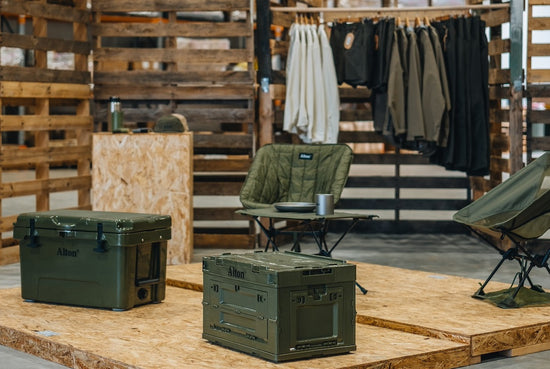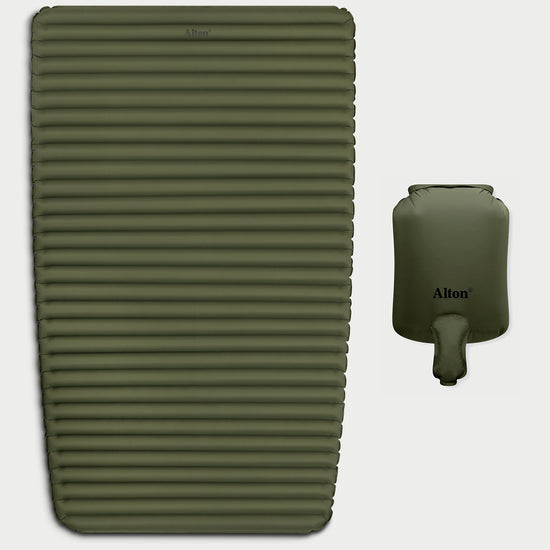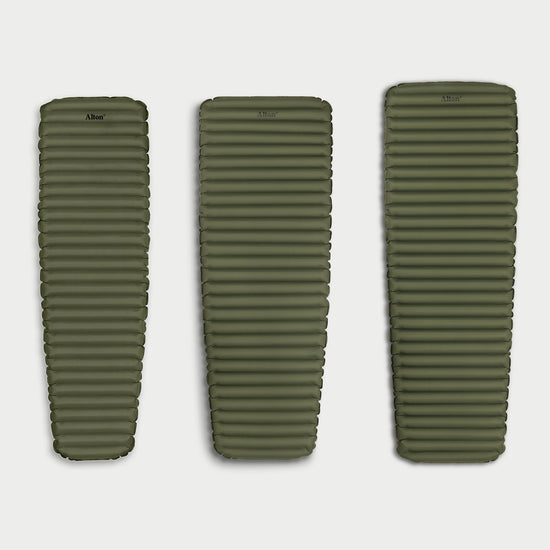If you have ever had a conversation about insulated sleeping pads, chances are that someone brought up the ‘R’ word.
Yep, we’re talking about R-value.
If you have ever found yourself wondering, “What is R-value? And why is it a big deal for sleeping pads?”, then this is the blog for you.
By the end of this article, you’ll know exactly what sleeping mat R-value means, why it matters and what rating you will need.
Ready? Let’s dive straight in!

What is R-value?
R-value is a scientific measure of thermal resistance based on principles of thermodynamics and heat transfer.
It can be used to calculate any material’s ability to resist the transfer of heat. The greater the thermal resistance of any given object or material, the more insulative it will be.
When used in the context of sleeping mats for camping, R-value indicates a sleeping mat's ability to insulate you from the cold ground, and provides a standardised measurement to gauge how effective it will be in low temperatures.
In the most simple terms, the higher the R-value of your sleeping pad, the better it will be at keeping you warm.
For example, a sleeping mat with an R-value of 4.0 will prevent heat loss to the ground more effectively (and thus keep you warmer) than a sleeping mat with an R-value of 1.0.
Making sense so far? Great!
Why does sleeping mat R-value matter?
The R-value is THE most important factor to consider when choosing a sleeping mat.
Why?
Easy. If the R-value rating of your sleeping pad is not high enough, and therefore insulative enough, for the conditions, you’ll be cold and miserable, all night long.
When you lie on a sleeping mat, your body heat naturally conducts to the cool surface of the ground beneath you.
Even in mild climates, the ground is often much colder than the air, leading to significant heat loss.
Without adequate insulation, this causes you to lose body heat quickly.
In cool conditions, having a sleeping mat with a R-value rating that is too low might cause you to feel cold and uncomfortable throughout the night.
But, in freezing weather, not having a sleeping mat with a high enough R-value for the conditions can quickly lead to hypothermia, which can be life-threatening.

Sleeping Pad R-Value Chart
We’ve put together this chart to show you what R–value rating you should go for, based on whether you are a warm or cold sleeper.
This chart can be used to help you choose the best sleeping mat R-value for your needs. These sleeping mat R-values are based on our recommended comfort ratings.
A comfort rating refers to minimum R-value needed to sleep comfortably in any given temperature, assuming you're also using an appropriate sleeping bag and shelter for the conditions.

What sleeping mat R-value rating do YOU need?
The specific R-value rating that you need for a sleeping mat will depend on three main considerations: the external conditions, individual differences, and your sleep system setup.
External Conditions → the temperature/weather conditions you are camping in.
Individual Differences → whether you are a ‘hot sleeper’ or a ‘cold sleeper’.
Sleep System Setup → the combined warmth of all your other sleeping gear.
Let’s go through each of these in detail.

External Conditions
Here are the recommended R-values for different weather conditions.
R-Value 0.5 to 2.0 – Warm conditions
A sleeping mat with an R-value of 1.0 to 1.5 is going to be ideal for warm weather conditions where the temperature does not drop below 10º overnight.
R-Value 2.0 to 3.5 – Cool conditions
Camping mats in this category are great all-rounders because they can be used for anything from warm summery weekends away to chilly autumn adventures. An R-Value of 2.0 to 3.5 will be sufficient to keep you warm in temperatures as low as 5º.
R-Value 3.5 to 5.0 – Cold conditions
If you are camping in cold conditions where the temperature is guaranteed to drop to freezing (or even just below it) overnight, then you will need a sleeping mat with an R-value in the 4.0 to 5.0 range.
R-Value 5.0+ – Extreme conditions
For adventurers who camp in extremely cold, winter conditions with overnight temperatures below -5ºC , a sleeping mat with an R-value of 5.0 or higher is advisable.

Individual Differences
Your metabolic rate, body composition, circulation, hormones, and sensitivity to cold can all affect how much heat your body generates, and how warm you feel while you sleep.
And all of these subtle individual differences have a surprisingly big impact on what the best sleeping mat R-value for you will be.
As a general rule of thumb, women typically 'sleep colder' than men, meaning they require a higher R-value to keep warm compared to men. But there is a lot of individual variation from person to person, so our advice is to consider your personal experiences and cold sensitivity when making your choice.
Warm Sleeper
If you run hot and find yourself prone to overheating at night, then you may want to consider going for a sleeping mat with an R-value on the lower end of the suggested ratings for each temperature category.
Cold Sleeper
If you notice that you need extra blankets at home, often get chilly at night, or just feel like you're more sensitive to the cold, then you should choose a sleeping mat with an R-value on the higher end of the recommended ratings. You may even find that you'll be more comfortable with a sleeping mat in the next warmth category up.

Sleep System Setup
Last but not least, your sleep system setup will influence your camping mat R-value rating requirements.
Your ‘sleep system’ includes everything else that goes into your setup for sleeping outdoors, from the shelter type, such as a hut, tarp or tent, to your sleeping bag, along with any extra items such as a sheet or liner.
Here are a couple points to consider when choosing the best sleeping mat r-value for your complete sleep system:
Your shelter makes a huge difference to how warm you feel.
Every part of your sleep system plays a role in keeping you warm. However, the type of shelter you use will make a huge difference to how warm you feel.
If you're sleeping inside a good 2-3 season tent with the rainfly on, the ambient temperature will be a few degrees warmer compared to outside. This adds about 2-4ºC of extra warmth, just from your body heat and breathing.
On the other hand, if you're sleeping in a tarp, there will be minimal to no difference between the air temperature inside and outside of the shelter. You'll also be more exposed to the wind, which can also cause some additional heat loss if you're not properly equipped. This means you'll be more reliant on your sleeping mat and sleeping bag to keep you warm when tarp camping.
There's no right or wrong shelter, but it is important to understand how your sleep system works together to keep you warm.

You can use a high R-value sleeping mat in warm weather.
A sleeping mat with a higher R-value (3.0+) will feel warmer compared to a sleeping mat with a lower rating because it retains the heat your body radiates.
This doesn’t necessarily make you hotter, but it does help to keep your body temperature consistent as you sleep.
By comparison, a low R-value camping mat (0.5–2.0) will feel cooler to sleep on in warm weather because it allows the heat from your body to dissipate away into the ground, instead of trapping it inside the mat.
However, some camping mats with heat-reflective technology are designed to redirect warmth back to your body, which could cause you to overheat if used in hot weather.
Your sleeping bag and your sleeping mat need to work together.
A common mistake people make when camping in cool or cold conditions is relying solely on their sleeping bag for warmth.
Your sleeping bag cannot make up for a sleeping mat that doesn’t have a high enough R-value for the conditions.
A sleeping bag provides warmth because the lofting filling retains the heat given off by your body. Anywhere that it is compressed, such as underneath you, the insulative properties of your sleeping bag are significantly diminished.
So, without adequate insulation beneath you, all your hard-earned warmth will just dissipate away into the ground – no matter what warm rating your sleeping bag has.
Your sleeping bag and camping mat work together to form the foundation of your sleeping system, so it is essential that both these items are warm enough for conditions you’re camping in.

Now you know what sleeping mat R-Value is!
Now you know all the fundamentals of sleeping mat R-value. By taking the time to read this article, you should now have a solid understanding of how R-value works, why it is important and how to choose the best sleeping mat R-value for your needs.
If you have any other questions, don’t hesitate to send us an email or DM on Instagram, we’re here to help.









